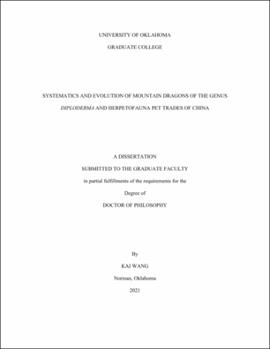| dc.description.abstract | To better study and conserve the biodiversity around us, one must have an accurate understanding of their taxonomy. Problematic taxonomy or lack of taxonomic knowledge not only mask signals of unique evolutionary stories, but they can also lead to misleading conservation assessments, resulting in detrimental impacts on endangered species. Being one of the most diverse and unique groups of vertebrates, non-avian reptiles constitute a major portion of the world’s biodiversity. Compared to megafauna groups such as birds and mammals, non-avian reptiles are the least studied, and their taxonomy is still far from stable. Such lack of taxonomic knowledge is most evident in the global biodiversity hot spots with a complex geological history, including the Hengduan Mountain Region (HMR) of southwest China. Among the reptilian species of Southwest China, Mountain Dragons of the genus Diploderma are of particular research interests: a rich cryptic diversity that remains undescribed in the genus, and this major agamid radiation shows a great potential to tackle the outstanding debates on the complex biogeographic patterns in the HMR.
For Chapter 2, I conducted the first comprehensive, integrative taxonomic study of the genus Diploderma, using a multi-locus genetic data and morphological data from densely sampled populations across southwest China. My results reveal that the previously identified D. flaviceps complex in HMR consists of six unidentified lineages, all of which are paraphyletic to true D. flaviceps. Each of the six lineages is also deeply diverged and morphologically distinct from each other and from all recognized species, showing a 5–15% uncorrected genetic divergence on mitochondrial gene ND2 and a suite of morphological characteristics, particularly gular coloration. Therefore, adapting the evolutionary species concept, I describe the six lineages of the D. flaviceps complex as six new species. Based on my conservation assessments using the International Union of Conservation of Nature (IUCN) criteria, four of the six new species are considered as Vulnerable (VU) due to habitat destruction, and two are considered Data Deficient (DD). I also discuss the challenges that unstable taxonomy poses on the conservation legislation of China and call for conservation attention of species of the genus Diploderma.
Building on the results from Chapter 2, I further examine the evolutionary and biogeographic history of the genus in the Hengduan Mountain Region (HMR) in my third chapter. Bayesian analyses show that the genus Diploderma consists of two major clades, and their distributions correspond to the paleo-Red River and paleo-Yangtze River Drainages, respectively, which can be delimited by a botanic biogeographic line, Tanaka-Kaiyong Line (TKL), near perfectly. These results support the TKL as a general biogeographic line and support the previously speculated link between TKL and drainage reorganization. Dated phylogeny of Acrodont lizards placed the divergence time between the two major clades of Diploderma in the late Oligocene/early Miocene at around 24 million years ago (Ma), which is consistent with the hypothesized timing of paleo-drainage capture and the timing for the active period of major tectonic faults in the region. These aligned timings further confirm the previously speculated links among biogeographic lines, drainage reorganization, and tectonic faults. In addition, species from the Salween River valley forms the only monophyletic drainage-wide species assemblage, which supports another biogeographic line, Mekong-Salween Divide, as an effective zoogeographic barrier. Model tests using BioGeoBEARS support the paleo-connections between paleo-Jinsha, paleo-Mekong, paleo-Yalong, and paleo-Red Rivers, although the connection between Salween and paleo-Red River drainages remain questionable. Ancestral range reconstruction using BioGeoBEARS shows that the genus Diploderma originated in the southern region at low elevation, and species underwent northward dispersals along major rivers into the HMR. The upper reaches of all major rivers except Salween were colonized from multiple cross-valley dispersal events in the late Miocene through Pliocene, which revealed the possibilities of novel river capture events in northern HMR. Finally, the ancestral state reconstruction shows that the most recent common ancestor of Diploderma was arboreal, and subsequent northward dispersal along river valleys fueled the multiple independent evolutions of the terrestrial ecotype.
Lastly, for Chapter 4, I assess the history, contemporary extent, taxonomic and regional preferences, and potential impacts of China’s herpetofauna pet trade, using data from four major sources: 20 years of international trade records from the Convention on International Trade in Endangered Species (CITES) and the Law Enforcement Information System of the United States Fish and Wildlife Service (LEMIS) from 2000–2019, online surveys of Chinese social media (WeChat) and online forums for up to two years, online questionnaires of 2,264 herpetoculturists across China, and an online search of confiscation records from 2008 to 2020. Results show that herpetofauna trade in China has a long history tracing back to 1975, and the contemporary herpetofauna pet trade of China is at an exceptionally large scale, with China being both a major consumer and a major supplier. China’s trade volume is biased taxonomically, concentrating on a small subset of common species, and the trade shows distinct preferences on species origin and taxonomic groups, biasing for exotic Testudines and native Sauria species in its consumption and supply trade, respectively. Additionally, China’s trade also displays a distinct regional pattern among major political regions of China, with Mainland China and Hong Kong being both the main importers and exporters. For legality, a high percentage of recorded exotic CITES species in China’s trade does not have legal import records, and a large volume of species was trafficked into and out of China through Hong Kong. The extent of contemporary herpetofauna pet trade by China is overlooked and underestimated, and the resulting lack of effective regulation has led to major conservation concerns, including high risk of exotic invasion and high exploitation pressures on CITES I endangered species, China’s native species in general, and all Testudines species. Based on the results, I provide specific recommendations to the regulatory and law enforcement agencies. | en_US |

